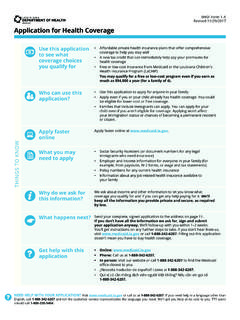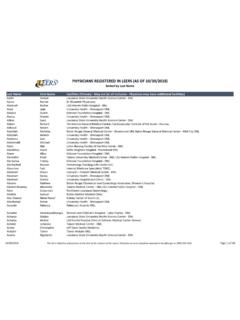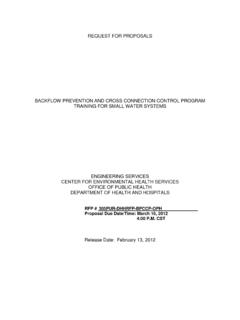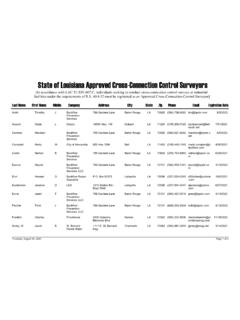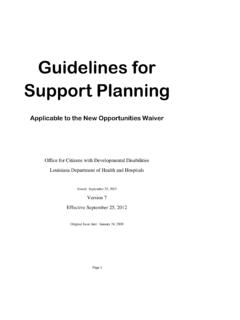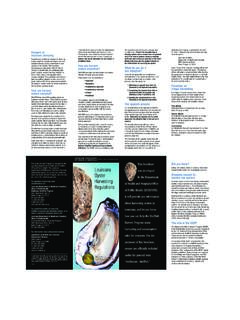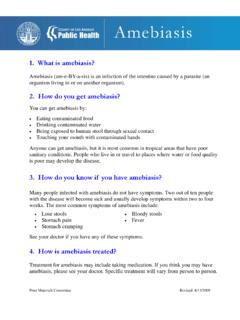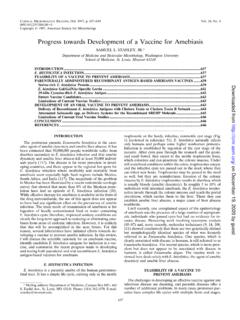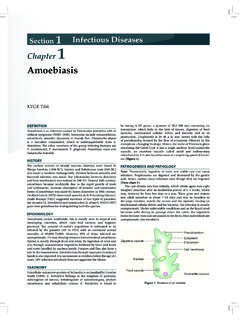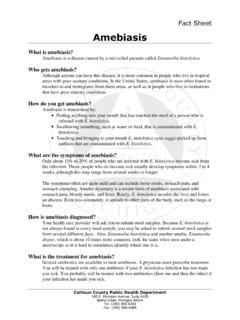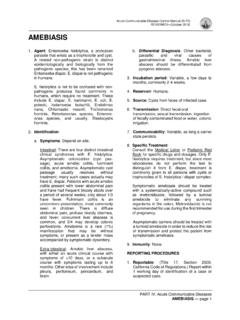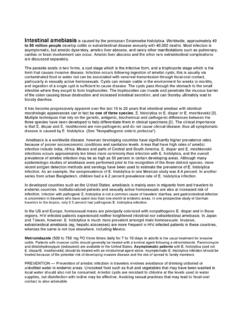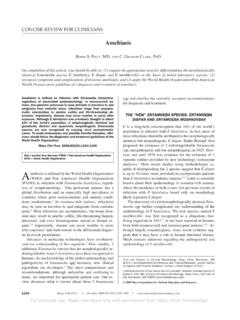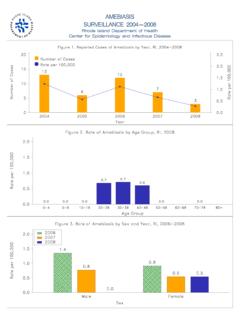Transcription of Amebiasis - ldh.la.gov
1 Amebiasis Annual Report 2016 Louisiana Office of Public Health Infectious Disease Epidemiology Section Page 1 of 4 Amebiasis Amebiasis is no longer a reportable disease in Louisiana. Outbreaks, however, should still be reported. Amebiasis (amoebiasis) is a parasitic infection caused by Entamoeba histolytica or Entamoeba dispar. The parasite is transmitted by the fecal-oral route, either through direct contact with feces or through the consumption of contaminated food or water. Between 80% and 90% of infected individuals develop no symptoms. For symptomatic cases, the incubation period between infection and illness can range from days to weeks. The symptoms are typically gastrointestinal issues, such as diarrhea or stomach pains.
2 It is also possible for the parasite to spread to the liver and cause abscesses. Entamoeba histolytica can be found world-wide but is more prevalent in tropical regions with poor sanitary conditions. In some areas with extremely adverse conditions, the prevalence can be as high as 50% in the population. There are no recent data on prevalence of Amebiasis in the , however, prevalence is estimated to be between 1% and 4% of the population. High risk groups are refugees, recent immigrants, travelers (particularly those who have spent long periods of time in an endemic area), institutionalized people (particularly developmentally or mentally-impaired people), and men who have sex with men. The number of cases reported within Louisiana is usually low. There are typically less than ten cases per year with a few exceptions (Figure 1).
3 Figure 1: Amebiasis cases - Louisiana, 1970-2016 051015202530354070 72 74 76 78 80 82 84 86 88 90 92 94 96 98 00 02 04 06 08 10 12 14 16 Number of CasesYearAmebiasis Annual Report 2016 Louisiana Office of Public Health Infectious Disease Epidemiology Section Page 2 of 4 Hospitalization Hospitalization surveillance is based on Louisiana Hospital Inpatient Discharge Data (LaHIDD). In 1997, the Louisiana legislature mandated the reporting of hospital discharge data. LaHIDD serves as the state registry for hospital discharge data submitted to the Louisiana Department of Health (LDH). The Office of Public Health (OPH) is responsible for providing the data to OPH sections as needed.
4 The Infectious Disease Epidemiology Section uses these data sets for surveillance of infectious diseases in hospitals. The data is available after a delay of two years. LaHIDD data sets contain demographic information (names, gender, age, date of birth, address), admit diagnosis, discharge diagnoses (main diagnosis plus eight additional diagnoses), procedures (main plus five), charges, length of stay and hospital name. The diagnoses and procedures are coded with ICD-9 codes. Repeat hospitalizations are not included in the analysis. Records of patients with Amebiasis were extracted using the following ICD9 codes, whether the code was identified in the main diagnosis or in the eight additional secondary diagnoses: CODE DISEASE 006 Amebiasis Acute Amebic Dysentary without mention of abscess Chronic Intestinal Amebiasis without mention of abscess Amebic Nondysenteric Colitis Amebic Liver Abscess Amebic Lung Abscess Amebic Brain Abscess Amebic Skin Ulceration Amebic Infection of other sites Amebiasis , unspecified Hospitalization Numbers, Rates and Trends The following statistics are based on de-duplicated patient records.
5 For the entire period, the hospitalization rate was per 100,000 population; rates ranged from to per 100,000 population. The number of hospitalizations ranged from one to eight per year (Figure 2). Amebiasis Annual Report 2016 Louisiana Office of Public Health Infectious Disease Epidemiology Section Page 3 of 4 Figure 2: Amebiasis hospitalizations Louisiana, 1999-2014 Hospitalization rates due to Amebiasis have been steady since 2008. Peak hospitalization rates were seen in 2000 ( per 100,000). The lowest hospitalization rates occurred in 2014, ( per 100,000). The regression line shows that the slope of the decreasing rate is per 100,000 population per year (Figure 3).
6 Figure 3: Rate of Amebiasis hospitalizations per 100,000 population - Louisiana, 1999-2014 Gender The trends in hospitalization by gender have been variable in the years 1999 to 2014. The overall rate of Amebiasis hospitalization was per 100,000 for males and per 100,000 for females. Currently, based on trend lines, male hospitalization rates for Amebiasis are decreasing and rates for females remain steady (Figure 4). 0123456789990001020304050607080910111213 14 Number of HospitalizationsYeary = + Rate per 100,000 PopulationYearAmebiasis Annual Report 2016 Louisiana Office of Public Health Infectious Disease Epidemiology Section Page 4 of 4 Figure 4: Hospital rates for Amebiasis by gender Louisiana, 1999-2014 Race Rates were not calculated due to the small number of cases and high proportions of unknown.
7 Age Group Amebiasis generally targets those individuals who live in tropical areas with poor sanitary conditions, although anyone can acquire this disease. Rates by age group were very low, showing no major differences by age group: zero per 100,000 in children (age group newborn to 14 years), per 100,000 in older children and adults (age group 15 to 64 years), and per 100,000 in the elderly (age group 65 years and older). Seasonality Seasonal variation has been recorded in tropical areas overseas where Amebiasis is more prevalent. However, this seasonal component generally reflected water shortages where the consumption of contaminated water became more prevalent. Consistent with the United States, Louisiana s cumulative data for the years 1999 to 2010 show that Amebiasis hospitalization rates are not influenced by season.
8 Clinical data Most cases are intestinal (75%). Twenty-three percent (23%) of the cases reported liver abscesses and only one case reported a lung abscess. Mortality There was one death attributed to Amebiasis in 2000. Rate per 100,000 PopulationYearMaleFemal

